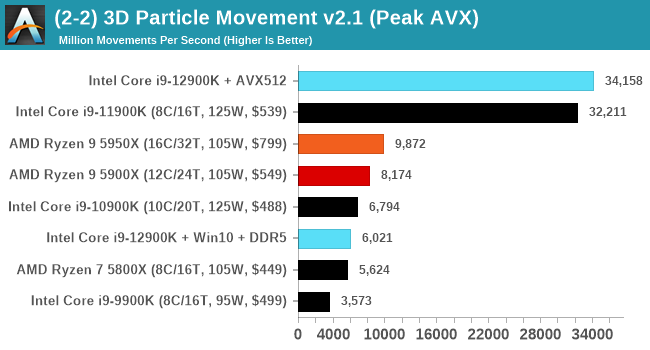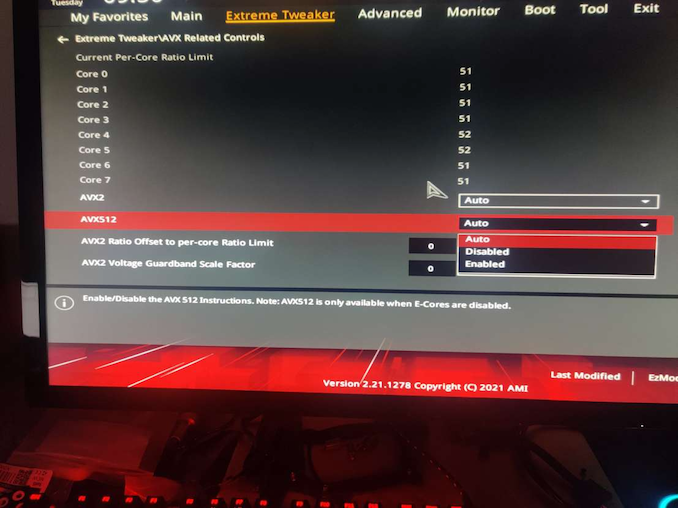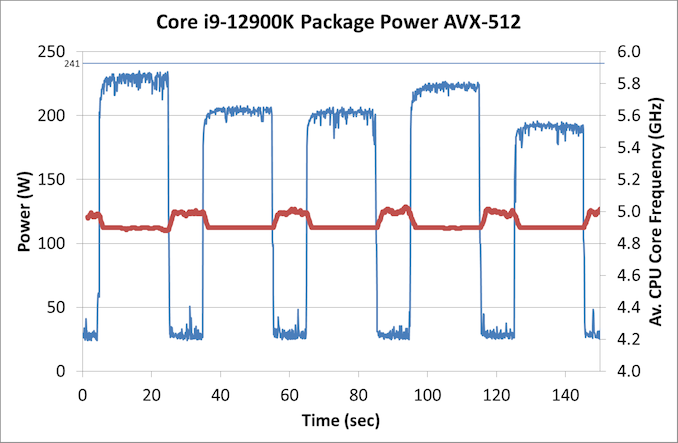The Intel 12th Gen Core i9-12900K Review: Hybrid Performance Brings Hybrid Complexity
by Dr. Ian Cutress & Andrei Frumusanu on November 4, 2021 9:00 AM ESTIntel Disabled AVX-512, but Not Really
One of the more interesting disclosures about Alder Lake earlier this year is that the processor would not have Intel’s latest 512-bit vector extensions, AVX-512, despite the company making a big song and dance about how it was working with software developers to optimize for it, why it was in their laptop chips, and how no transistor should be left behind. One of the issues was that the processor, inside the silicon, actually did have the AVX-512 unit there. We were told as part of the extra Architecture Day Q&A that it would be fused off, and the plan was for all Alder Lake CPUs to have it fused off.
Part of the issue of AVX-512 support on Alder Lake was that only the P-cores have the feature in the design, and the E-cores do not. One of the downsides of most operating system design is that when a new program starts, there’s no way to accurately determine which core it will be placed on, or if the code will take a path that includes AVX-512. So if, naively, AVX-512 code was run on a processor that did not understand it, like an E-core, it would cause a critical error, which could cause the system to crash. Experts in the area have pointed out that technically the chip could be designed to catch the error and hand off the thread to the right core, but Intel hasn’t done this here as it adds complexity. By disabling AVX-512 in Alder Lake, it means that both the P-cores and the E-cores have a unified common instruction set, and they can both run all software supported on either.
There was a thought that if Intel were to release a version of Alder Lake with P-cores only, or if a system had all the E-cores disabled, there might be an option to have AVX-512. Intel shot down that concept almost immediately, saying very succinctly that no Alder Lake CPU would support AVX-512.
Nonetheless, we test to see if it is actually fused off.
On my first system, the MSI motherboard, I could easily disable the E-cores. That was no problem, just adjust the BIOS to zero E-cores. However this wasn’t sufficient, as AVX-512 was still clearly not detected.
On a second system, an ASUS motherboard, there was some funny option in the BIOS.
Well I’ll be a monkey’s uncle. There’s an option, right there, front and centre for AVX-512. So we disable the E-cores and enable this option. We have AVX-512 support.
For those that have some insight into AVX-512 might be aware that there are a couple of dozen different versions/add-ons of AVX-512. We confirmed that the P-cores in Alder Lake have:
- AVX512-F / F_X64
- AVX512-DQ / DQ_X64
- AVX512-CD
- AVX512-BW / BW_X64
- AVX512-VL / VLBW / VLDQ / VL_IFMA / VL_VBMI / VL_VNNI
- AVX512_VNNI
- AVX512_VBMI / VBMI2
- AVX512_IFMA
- AVX512_BITALG
- AVX512_VAES
- AVX512_VPCLMULQDQ
- AVX512_GFNI
- AVX512_BF16
- AVX512_VP2INTERSECT
- AVX512_FP16
This is, essentially, the full Sapphire Rapids AVX-512 support. That makes sense, given that this is the same core that’s meant to be in Sapphire Rapids (albeit with cache changes). The core also supports dual AVX-512 ports, as we’re detecting a throughput of 2 per cycle on 512-bit add/subtracts.
For performance, I’m using our trusty 3DPMAVX benchmark here, and compared to the previous generation Rocket Lake (which did have AVX-512), the score increases by a few percent in a scenario which isn’t DRAM limited.

Now back in that Rocket Lake review, we noted that the highest power consumption observed for the chip was during AVX-512 operation. At that time, our testing showcased a big +50W jump between AVX2 and AVX-512 workloads. This time around however, Intel has managed to adjust the power requirements for AVX-512, and in our testing they were very reasonable:
In this graph, we’re showing each of the 3DPM algorithms running for 20 seconds, then idling for 10 seconds. Each one has a different intensity of AVX-512, hence why the power is up and down. IN each instance, the CPU used an all-core turbo frequency of 4.9 GHz, in line with non-AVX code, and our peak power observed is actually 233 W, well below the 241 W rated for processor turbo.
Why?
So the question then refocuses back on Intel. Why was AVX-512 support for Alder Lake dropped, and why were we told that it is fused off, when clearly it isn’t?
Based on a variety of conversations with individuals I won’t name, it appears that the plan to have AVX-512 in Alder Lake was there from the beginning. It was working on early silicon, even as far as ES1/ES2 silicon, and was enabled in the firmware. Then for whatever reason, someone decided to remove that support from Intel’s Plan of Record (POR, the features list of the product).
By removing it from the POR, this means that the feature did not have to be validated for retail, which partly speeds up the binning and testing/validation process. As far as I understand it, the engineers working on the feature were livid. While all their hard work would be put to use on Sapphire Rapids, it still meant that Alder Lake would drop the feature and those that wanted to prepare for Alder Lake would have to remain on simulated support. Not only that, as we’ve seen since Architecture Day, it’s been a bit of a marketing headache. Whoever initiated that dropped support clearly didn’t think of how that messaging was going to down, or how they were going to spin it into a positive. For the record, removing support isn’t a positive, especially given how much hullaballoo it seems to have caused.
We’ve done some extensive research on what Intel has done in order to ‘disable’ AVX-512. It looks like that in the base firmware that Intel creates, there is an option to enable/disable the unit, as there probably is for a lot of other features. Intel then hands this base firmware to the vendors and they adjust it how they wish. As far as we understand, when the decision to drop AVX-512 from the POR was made, the option to enable/disable AVX-512 was obfuscated in the base firmware. The idea is that the motherboard vendors wouldn’t be able to change the option unless they specifically knew how to – the standard hook to change that option was gone.
However, some motherboard vendors have figured it out. In our discoveries, we have learned that this works on ASUS, GIGABYTE, and ASRock motherboards, however MSI motherboards do not have this option. It’s worth noting that all the motherboard vendors likely designed all of their boards on the premise that AVX-512 and its high current draw needs would be there, so when Intel cut it, it meant perhaps that some boards were over-engineered with a higher cost than needed. I bet a few weren’t happy.
Update: MSI reached out to me and have said they will have this feature in BIOS versions 1.11 and above. Some boards already have the BIOS available, the rest will follow shortly.
But AVX-512 is enabled, and we are now in a state of limbo on this. Clearly the unit isn’t fused off, it’s just been hidden. Some engineers are annoyed, but other smart engineers at the motherboard vendors figured it out. So what does Intel do from here?
First, Intel could put the hammer down and execute a scorched earth policy. Completely strip out the firmware for AVX-512, and dictate that future BIOS/UEFI releases on all motherboards going forward cannot have this option, lest the motherboard manufacturer face some sort of wrath / decrease in marketing discretionary funds / support. Any future CPUs coming out of the factory would actually have the unit fused out, rather than simply turned off.
Second, Intel could lift the lid, acknowledge that someone made an error, and state that they’re prepared to properly support it in future consumer chips with proper validation when in a P-core only mode. This includes the upcoming P-core only chips next year.
Third, treat it like overclocking. It is what it is, your mileage may vary, no guarantee of performance consistency, and any errata generated will not be fixed in future revisions.
As I’ve mentioned, apparently this decision didn’t go down to well. I’m still trying to find the name of the person/people who made this decision, and get their side of the story as to technically why this decision was made. We were told that ‘No Transistor Left Behind’, except these ones in that person’s mind, clearly.












474 Comments
View All Comments
michael2k - Thursday, November 4, 2021 - link
One is a bellwether for the other.Mobile parts will have cores and clocks slashed to hit mobile power levels; 7W-45W with 2p2e - 6p8e
However, given that a single P core in the desktop variant can burn 78W in POV Ray, and they want 6 of them in a mobile part under 45W, that means a lot of restrictions apply.
Even 8 E cores, per this review, clock in at 48W!
That suggests a 6p8e part can't be anywhere near the desktop part's 5.2GHz/3.9GHz Turbo clocks. If there is a linear power-clock relationship (no change in voltage) then 8 E cores at 3GHz will be the norm. 6 P cores on POV-Ray burn 197W, then to hit 45W would mean throttling all 6 cores to 1.2GHz
https://hothardware.com/news/intel-alder-lake-p-mo...
siuol11 - Thursday, November 4, 2021 - link
Except that we know that the power-clock ratio is not linear and never has been. You can drop a few hundred MHz off of any Intel chip for the past 5 generations and get a much better performance per watt ratio. This is why mobile chips don't lose a lot of MHz compared to desktop chips.michael2k - Thursday, November 4, 2021 - link
We already know their existing Ice Lake 10nm 4C mobile parts are capped at 1.2GHz to hit 10W:https://www.anandtech.com/show/15657/intels-new-si...
A 6p8e part might not clock that low, but I'm certain that they will have to for the theoretical 7W parts.
Here's a better 10nm data point showing off their 15W-28W designs:
https://www.anandtech.com/show/14664/testing-intel...
4C 2.3GHz 28W TDP
Suggests that a 4pNe part might be similar while the 6p8e part would probably be a 2.3GHz part that could turbo up to a single core to 4GHz or all cores to 3.6GHz
TheinsanegamerN - Thursday, November 4, 2021 - link
Yes, once it gets in the way of performance, and intel's horrible efficiency means you need high end water cooling to keep it running, whereas AMD does not. Intel's inneficiency is going to be an issue for those who like air cooling, which is a lot of the market.Wrs - Thursday, November 4, 2021 - link
Trouble is I'm not seeing "horrible efficiency" in these benchmarks. The 12900k is merely pushed far up the curve in some of these benches - if the Zen3 parts could be pushed that far up, efficiency would likewise drop quite a bit faster than performance goes up. Some people already do that. PBO on the 5900x does up to about 220W (varies on the cooler).jerrylzy - Friday, November 5, 2021 - link
PBO is garbage. You can restrict EDC to 140A, let loose other restrictions and achieve a better performance than setting EDC to 220A.Spunjji - Friday, November 5, 2021 - link
"if the Zen3 parts could be pushed that far up"But you wouldn't, because you'd get barely any more performance for increased power draw. This is a decision Intel made for the default shipping configuration and it needs to be acknowledged as such.
Wrs - Saturday, November 6, 2021 - link
As a typical purchaser of K chips the default shipping configuration holds rather little weight. A single BIOS switch (PBO on AMD, MTP on Intel), or one slight change to Windows power settings, is pretty much all the efficiency difference between 5950x and 12900k. It pains me every time I see a reviewer or reader fail to realize that. The chips trade blows on the various benches because they're so similar in efficiency, yet each by their design has strong advantages in certain commonplace scenarios.Spunjji - Friday, November 5, 2021 - link
If the competition are able to offer similar performance and you don't have to shell out the cash and space for a 360mm AIO to get it, that's a relevant advantage. If those things don't bother you then it's fine, though - but we're in a situation where AMD's best is much more power efficient than Intel's at full load, albeit Intel appears to reverse that at lower loads.geoxile - Thursday, November 4, 2021 - link
Clock/power scales geometrically. The 5900HS retains ~85% of the 5800X's performance while using 35-40W stable power vs 110-120W for the 5800X. That's almost 3x more efficient. Intel is clocking desktop ADL to the moon, it doesn't mean ADL is going to scale down poorly, if anything I expect it to scale down very well since the E-cores are very performant while using a fraction of the power and according to Intel can operate at lower voltages than the P-cores can, so they can scale down even lower than big cores like ADL P-cores and zen 3. ADL mobile should be way more interesting than ADL desktop.